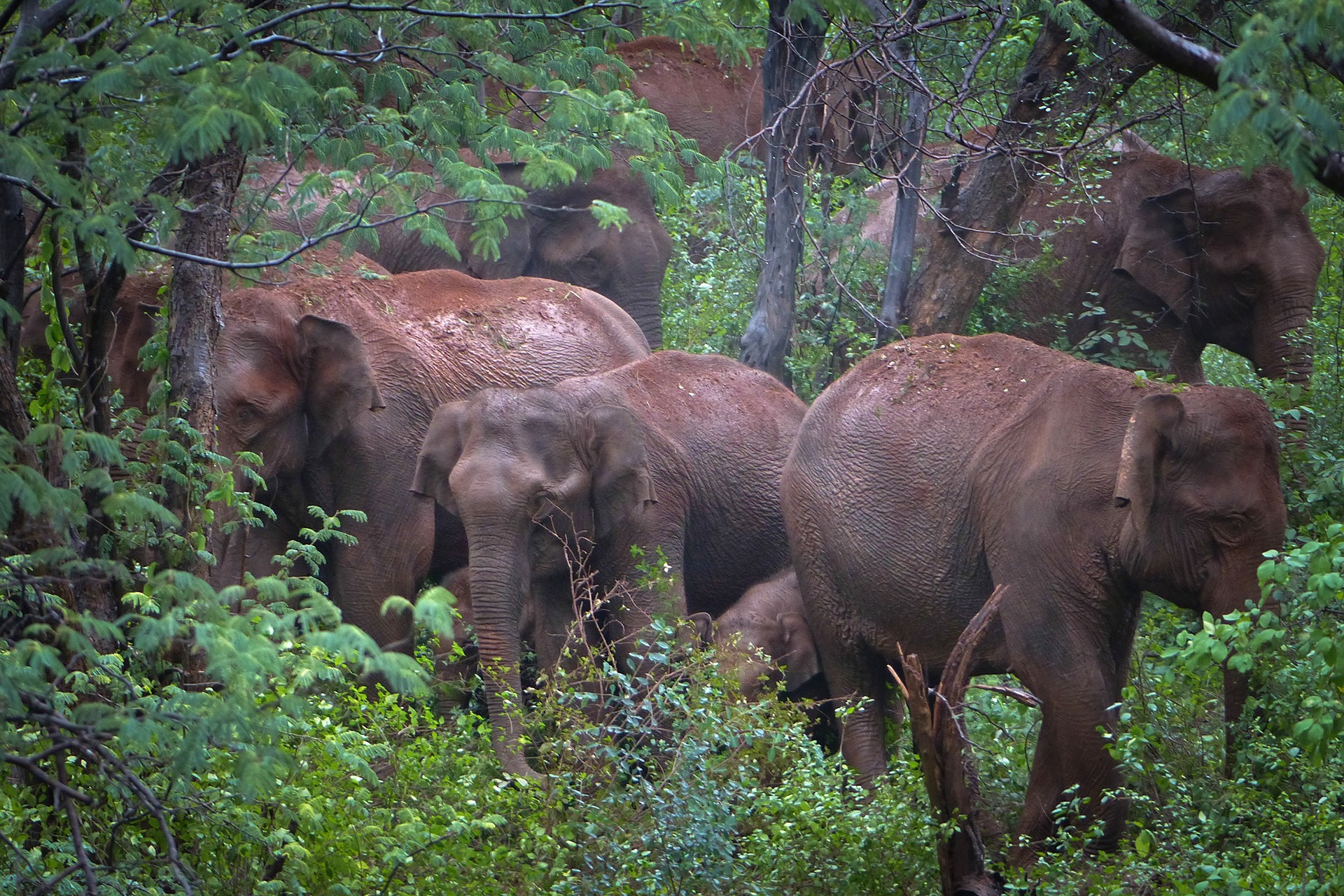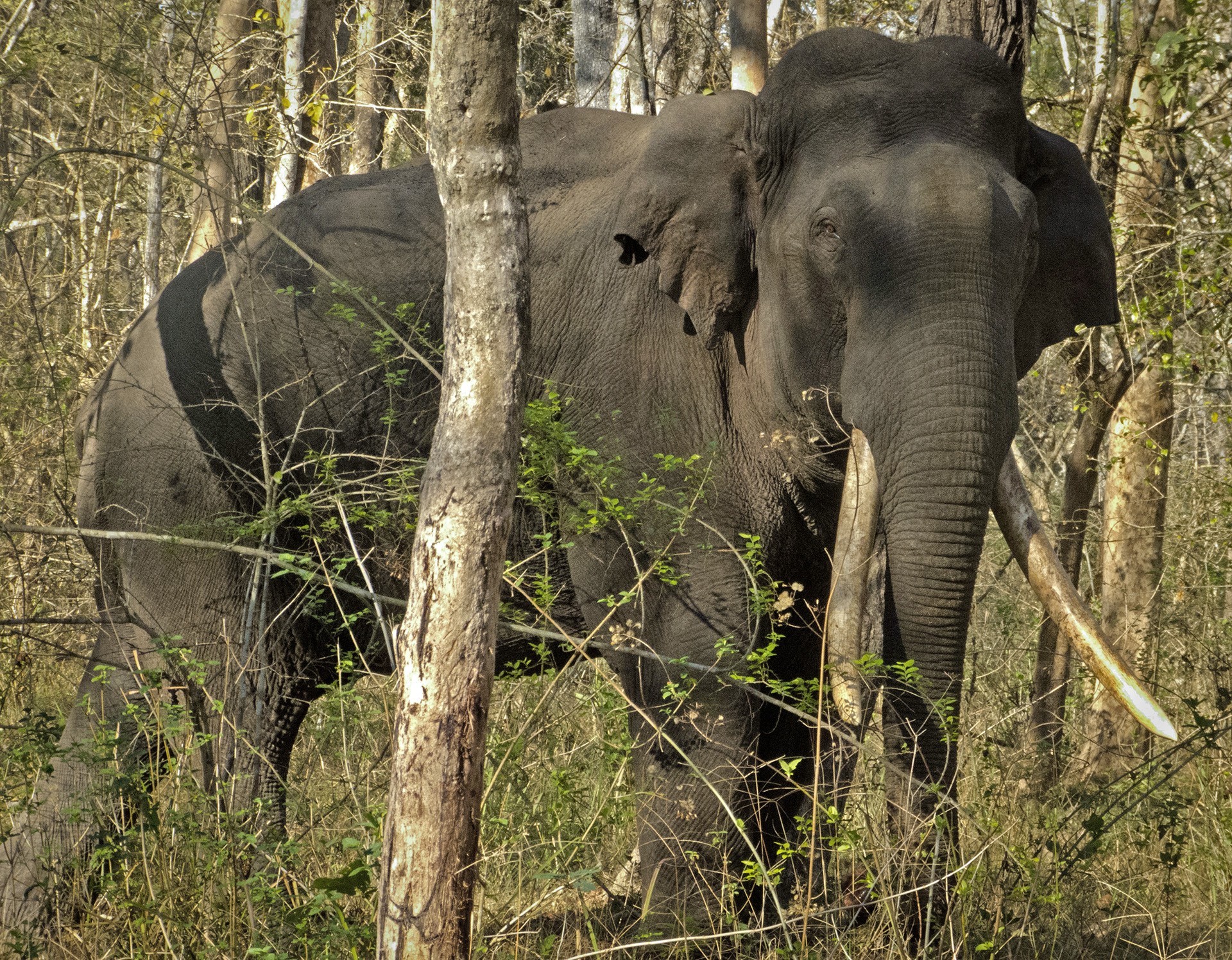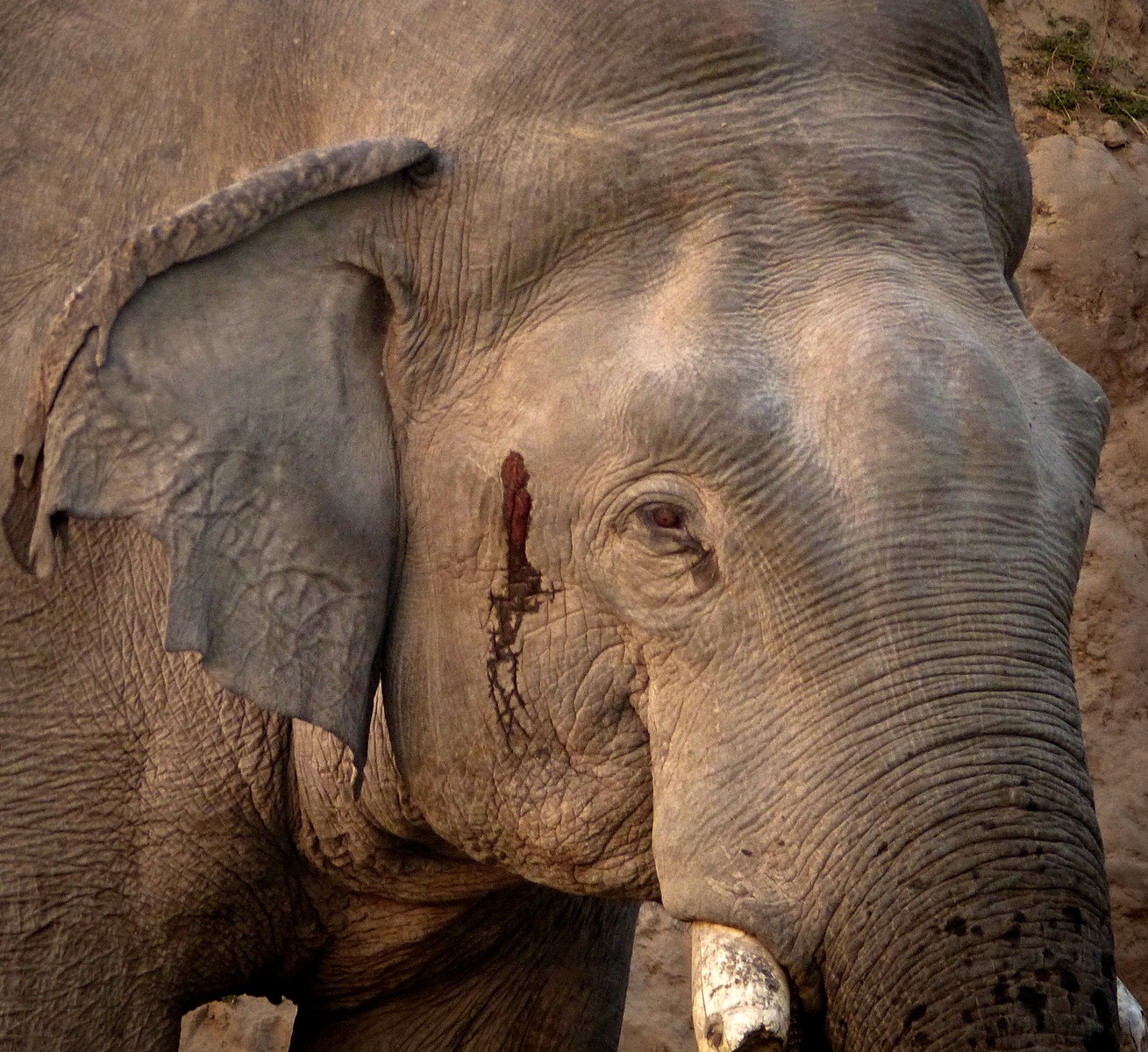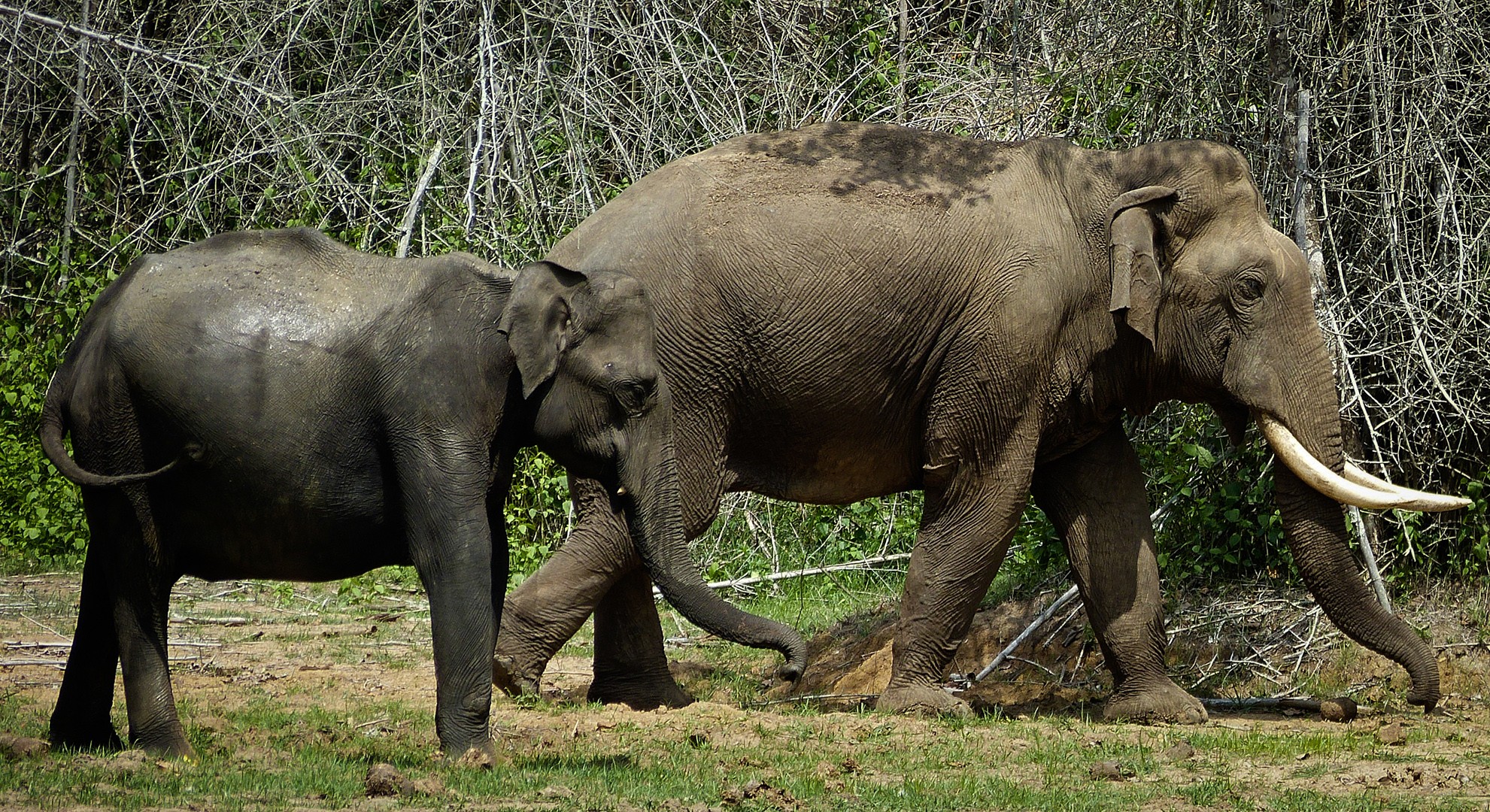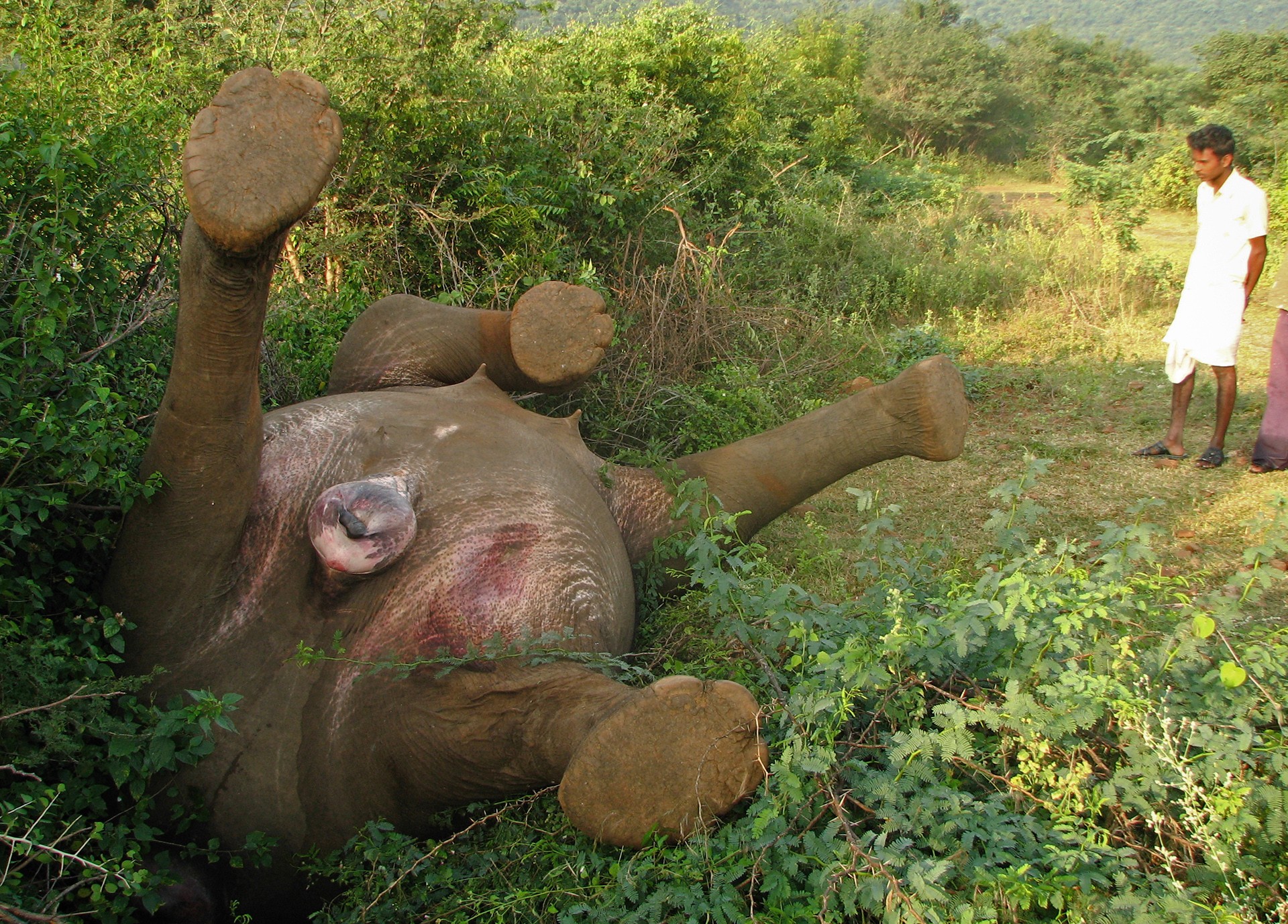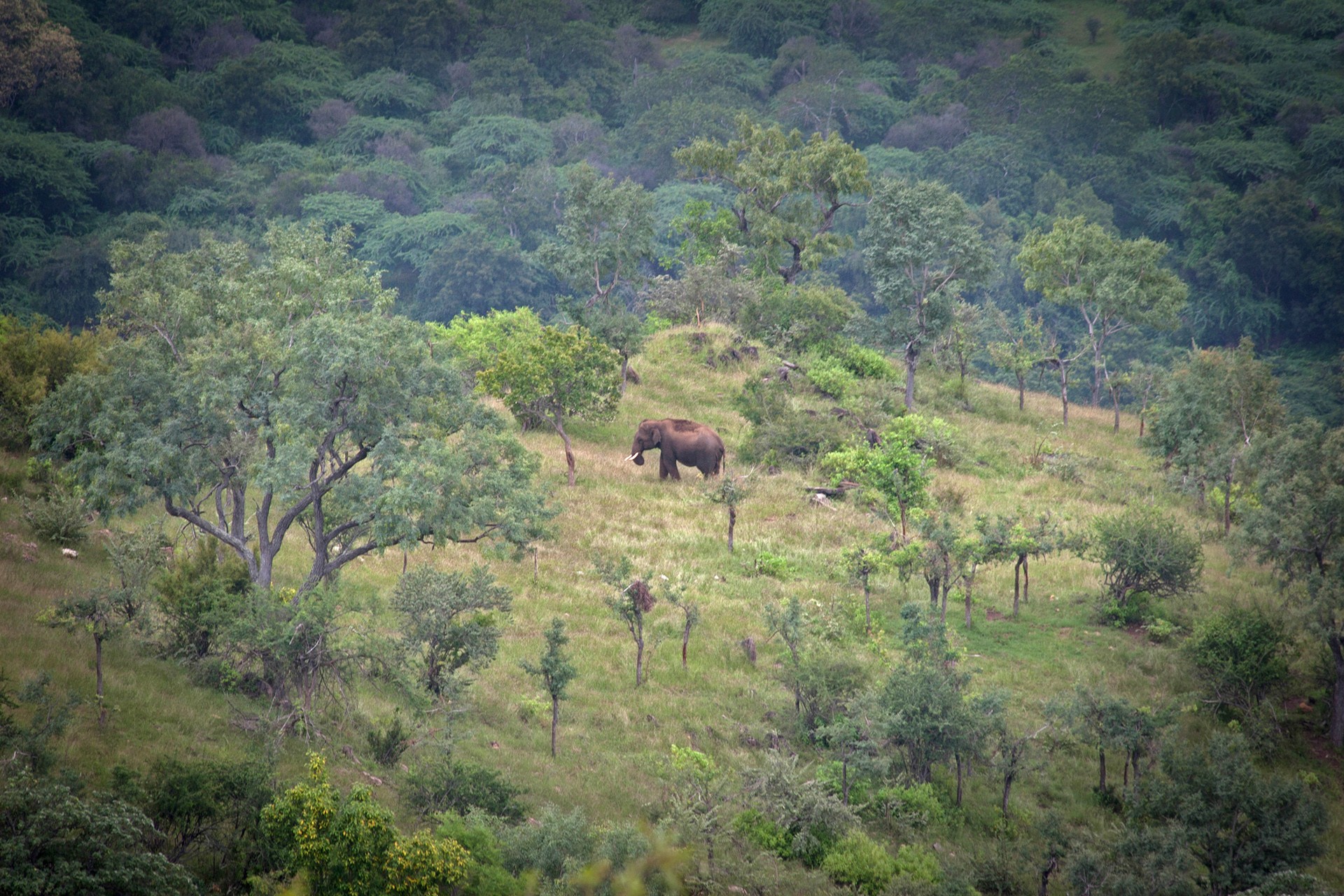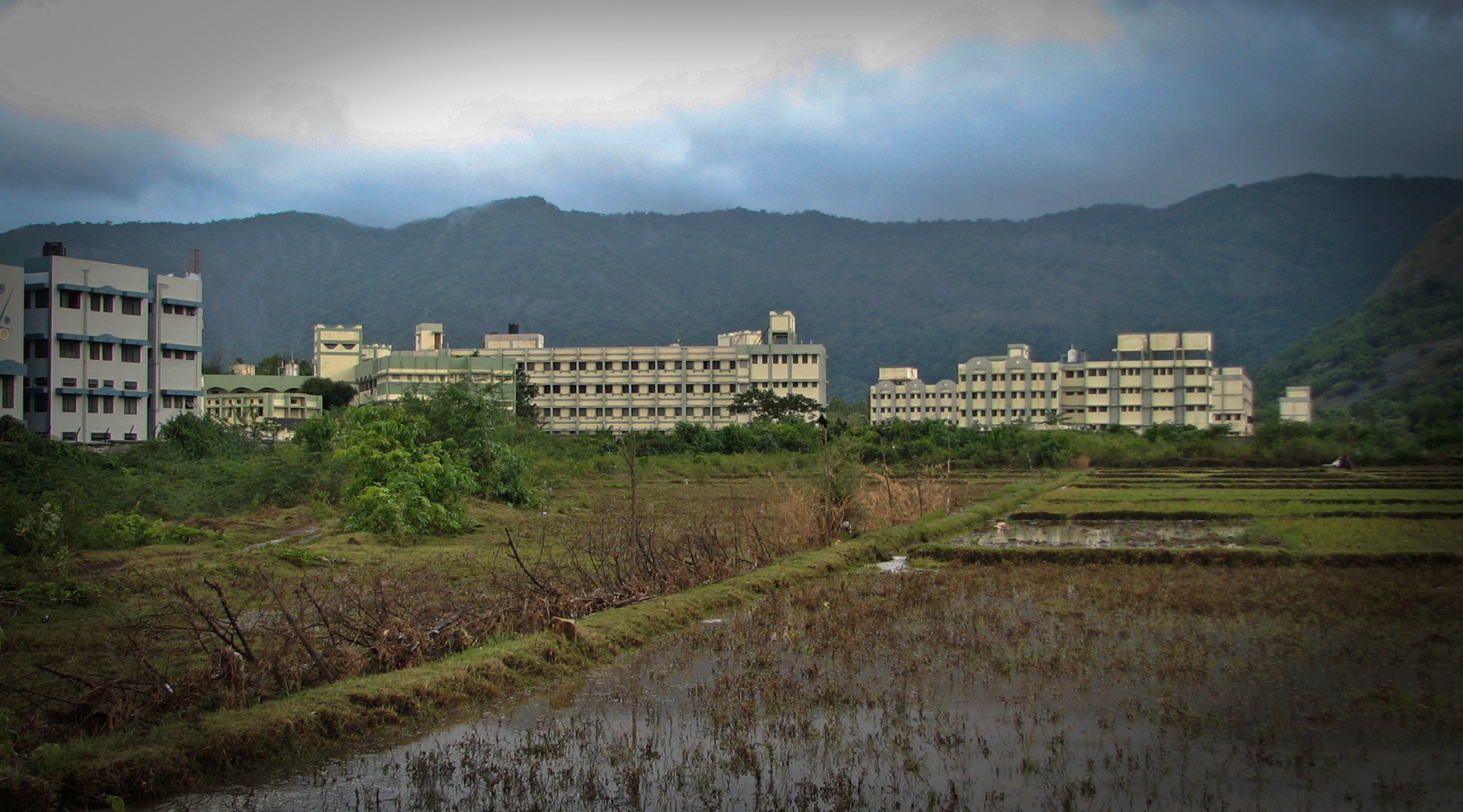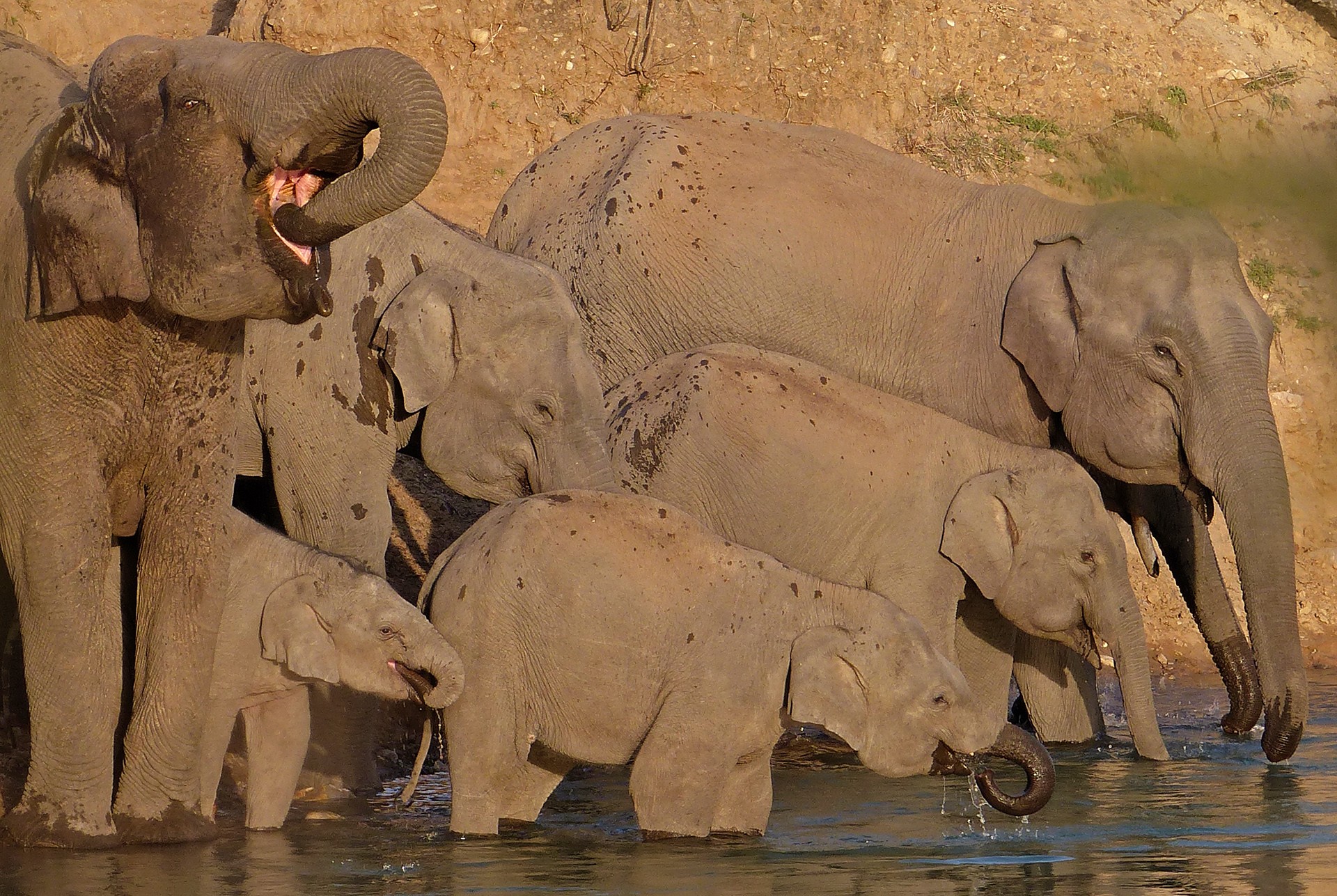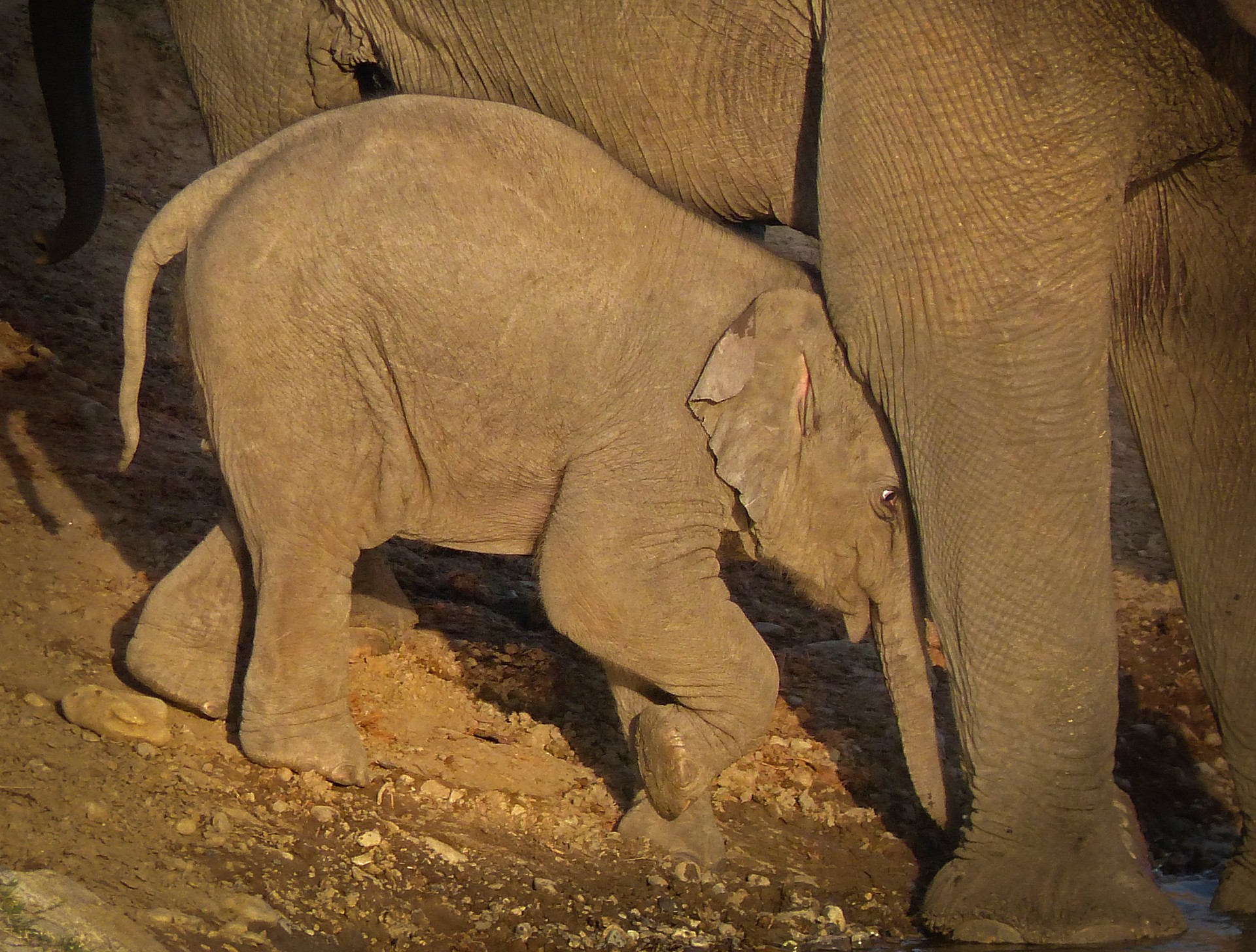The midday heat was oppressive – despite a brief spell of pre-monsoon showers – as we silently squatted near a bamboo thicket behind a waterhole. Although shallow and containing only turbid water, the waterhole was still one of the few perennial sources of water for wildlife in the vicinity that was frequented by large predators like tigers, leopards, and dholes, as well as their prey like sambar, chital, muntjac and gaur. During the summer, this became a good place to observe elephants, too. The jungle was unusually silent except for the incessant calls of the cicadas. My assiduous tribal tracker Baby, one of the best trackers I have had the opportunity to work with, knew that wild animals would soon start coming to the waterhole. He was on high alert.
Minutes later, a faint rustle that was barely audible to me, roused Baby – he stood up in a flash and whispered in Tamil, ‘aanai varuthu’ (elephants are coming).
We cautiously moved towards the edge of the waterhole, making sure that the wind was not carrying our scent to the elephants, which have one of the most well developed senses of smell among large mammals. The four elephants – two large cows, a sub-adult female and a calf, dashed into the water, submerged themselves contentedly, slaked their thirst and played for a while. But then, the breeze changed direction, alerting them to our presence. The sub-adult female became terrified and started running away. Securing the tiny calf under her legs, the larger of the two cows, a stately matriarch, immediately pacified the sub-adult by inserting her trunk into the mouth of the petrified elephant. This is the typical fashion in which elephant families respond to threats and reassure one another. The whole herd calmed down in a while. Once the matriarch was thoroughly convinced that we did not present a threat to them, they ambled into the thickets. This happened in May 2008, almost a decade ago in the forests of Top Slip in the Annamalai mountains of the Western Ghats.
The pivotal role of elders in elephant society
Observations such as this and many more from different elephant habitats exemplify the crucial role that matriarchs play in the wellbeing of the elephant family. Pioneering, long-term research by Cynthia Moss and her colleagues in Africa empirically prove that older matriarchs are able to discern even subtle threats and safeguard their families accordingly. In the absence of older matriarchs to guide them, the families could get lost and might even get split up into splinters, exposing them to a range of threats that include reduced survival prospects for calves, and traversing into hostile areas.
In African elephants, both males and females carry tusks, which are nothing but modified incisor teeth. Since the oldest elephants carry the largest and heaviest tusks, ivory poachers have selectively removed several matriarchs. Such selective removal has had devastating effects on entire elephant families, affecting their social and reproductive behaviour and survival prospects in the face of adversities such as droughts.
Fortunately, in Asian elephants, only males carry ivory and therefore, poachers do not target adult females. However, unlike the vastness of African elephant habitats, elephants in India and other parts of Asia live in ever-shrinking and ever-degrading tiny blotches of forests in the midst of intensive human-use areas. Lately, the problem of fragmentation by roads, railway lines, canals and power lines have not only fragmented elephant habitats, but have also resulted in numerous deaths. For example, just in the state of West Bengal, trains have mowed down over 80 elephants in the last few decades. Recently, there was a spate of electrocution in the state of Karnataka, wherein many elephants died.
It is not just the elephant deaths that are of concern. These losses have other potential ramifications that could affect elephant society, which in turn could influence their interaction with people. For example, if an elephant family loses an adult member in a freak incident such as electrocution or train collision, there is a high probability of the repository of spatial knowledge dying with that individual, leaving the family destitute. Matriarchs are important sources of spatial knowledge for elephant families – in other words, they know the blueprint of their home range. They know where critical resources like water, forage and shade would be amply available for their families, and they plan migrations within their home range accordingly. Families that prematurely lose matriarchs (before they can properly vertical transmit their roles to subordinates) could be in distress, could lose rank in the elephant social hierarchy, and might traverse to unfamiliar locations, often getting into heightened conflicts with people.
Similarly, the loss of large adult bulls not only removes a fine specimen from the gene pool, but also can potentially disrupt the dominance rank mechanisms of other males operating in the area. Such disruption can have untold effects, which in turn, can have direct bearing on elephant conservation management. A classic case worth mentioning here is the Pilanesberg elephant problem in South Africa, where, in the absence of large males, a few young males went on killing sprees, attacking numerous rhinoceros in Pilanerberg Park in the 1990s. Park managers had to come up with a novel intervention: they released unrelated large bulls into the park, which immediately resulted in a reduction of musth (a period of heightened sexual activity) in the younger males and consequently, brought to an end their aberrant behaviour.
Poaching of large tusk-bearing bulls was rampant in India till about a decade ago. Ivory poaching in India skewed the male to female ratio heavily in many regional populations. Lately, though, there are positive signs of some of the populations recovering from this skew. Thankfully, there now seems to be a lull in ivory poaching in India, although in Africa it continues to be a major driver of elephant population declines, with over 30,000 elephants being annually slaughtered for their ivory.
While the effect of such poaching on the population aspects (such as the skewed male to female ratio) was widely acknowledged, we know little about its effects on social aspects of elephants. A widespread notion exists amongst wildlife managers and even conservationists that the deaths of a few individual animals here and there is not a cause of concern. This notion may be overly simplistic for highly social animals like elephants. It shouldn’t be misunderstood that we need to make a hue and cry for every natural elephant death. However, unequivocally, any unnatural deaths due to electrocution, poaching and others is definitely a cause for worry, as such deaths could be the silent trigger for long-term conflict involving a family of elephants or a few individuals.
Known threats, imperceptible solutions
While the insidious threats of losing ‘key individuals’ may be less understood and appreciated, thanks to long-term research, the effect of habitat loss (caused largely by the expansion of agriculture, cash crop plantations, settlements, and the opening up of mines), fragmentation (caused largely by linear infrastructure such as roads, mines, and the expansion of agriculture and settlements) and degradation (caused largely by intensive cattle grazing, biomass removal and fire) are adequately known. However, the ominous fact is, these inimical threats continue to be pervasive all through the elephant range and policy mechanisms to stem them have been rather weak. As a result, in our country, we have failed to secure vital corridors and critical habitats, leaving elephant populations in pocketed habitats with long-term genetic consequences like inbreeding depression, which might render elephants vulnerable to diseases, and demographic consequences, such as altered age and sex ratios, that affect their breeding potential.
For example, in the landscape that is more familiar to me, viz., the Brahmagiri – Nilgiri – Eastern Ghats in south India, which supports the largest Asian elephant population in the world with over 9000 individuals, crucial corridors such as the Kallar in Coimbatore, Segur and Mukurthi in the Nilgiris and numerous others remain extremely tenuous, jeopardising the long-term resilience of elephant populations in the landscape. The story is similar in other regional populations as well.
Failure to secure crucial habitats and corridors in time can lead to several unintended ramifications that might seriously encumber conservation management. One such potential consequence is the displacement of elephants from their homes due to the loss of habitats or crucial corridors. The central Indian elephant population spanning the states of Odisha, Chhattisgarh, Jharkhand and parts of Bengal exemplify this problem: rich mineral wealth in the region has led to the large-scale opening up of mines and associated infrastructure development in hitherto prime elephant habitats, leading to the large-scale displacement of elephants.
Being a large mammal, elephants can move far and wide with home ranges straddling between 100 to 1000 square kilometres. Some of the displaced herds have re-colonised states like Chhattisgarh, northern parts of Andhra Pradesh etc (I use the term recolonise because even these states historically had elephant populations, which subsequently became locally extinct). In Chhattisgarh, where we (Dr Bivash Pandav and the team from the Wildlife Institute of India) recently began surveys that were designed to understand elephant movement patterns and population aspects, there are only a few hundred elephants distributed over several thousand square kilometers of forests. However, the forests are highly fragmented and perforated with villages, creating a convoluted land matrix where human–elephant conflict appears inexorable, with over 100 humans and a fourth of elephants dying every year. Thus, the re-colonisation of elephants in the state has created periods of turbulence, with widespread human and elephant casualties. This sorry state of affairs could have been easily avoided if the ‘original’ habitat (from where the elephants were displaced) was properly protected.
Large-scale disturbances in their habitat continue to be the main reason why elephants start coming into human use areas. While many state forest departments are grappling with conflict concerning displaced elephants, paradoxically, human development continues to make inroads into intact elephant habitats. Therefore, unless we stem the well-recognised threats to intact elephant habitats in the first place, we might incur far more social, economic and political costs.
Hope springs eternal
Elephants are the products of 60 million years of evolution. They have gone through many spikes and troughs in an evolutionary timescale, but have persisted over the test of time due to their large body size and remarkable behavioural adaptability, which help them to endure a wide range of environmental stress. Over eras, they have shaped landscapes and ecosystems of which they are an integral part. Ecologists argue that large herds of large herbivores are our only line of defense against the ‘aridification' of land, which takes place at an alarming pace in regions depauperate of large herbivores. This is because large herbivores directly mediate the primary productivity of the ecosystem through their mulch and trampling effects. For example, elephants act as ecosystem engineers and seed dispersers, and facilitate the existence of meso-herbivores (small herbivores) like deer. They also help in effective nutrient cycling through their dung and urine. In India, elephants play a crucial role in the ecology of tropical forests, which are the source of major life-supporting rivers and carbon sinks. Thus, there is no doubt that efforts to conserve elephants have direct benefits to mankind.
The time has come for us to obstinately desist from fragmenting the last remaining fraction of elephant habitats. In some pristine elephant habitats, there are numerous linear infrastructure developments in the offing. Many are roads, railway lines and highways that will fragment forests. There is a complacence that mitigation measures can alleviate some of the effects of these linear infrastructures on forests and wildlife. The reality is, the effect of fragmentation is more insidious and lasting: it can directly affect vegetation and primary productivity reducing forage availability, it can lead to the degradation of forests, making them unsuitable for large mammals, affect animal communication and much more. Therefore, mitigation structures are not substitutes for maintaining an intact habitat.
Elephant habitats constitute a small fraction of land area in the country and therefore, if linear infrastructure is inevitable, we need to work them around these elephant habitats and not through them. Complacence in this regard can only be devastating. As citizens, we should urge the government not to allow any further fragmentation in elephant habitats. Elephants can definitely persist, but they need our help. On World Elephant Day, let us firmly resolve that we won’t let millions of years of elephant evolution come to an abrupt end.
